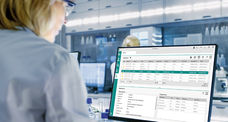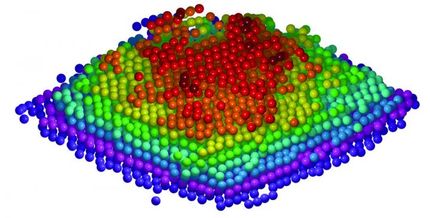Software for the discovery of new crystal structures
Advertisement
A new software called QED (Quantitative Electron Diffraction), which has been licensed by Max Planck Innovation, has now been released by HREM Research Inc., a Japan based company, which is developing products and services in the field of High-Resolution electron microscopy. QED allows transmission electron microscopes to acquire novel kinds of data, opening up new possibilities in electron crystallography.
Transmission electron microscopes create magnified images of samples and are, in contrast to the light microscope, even able to resolve individual atoms. When transmitting a beam of electrons through a crystalline sample such as a complex mineral or a crystallized protein, the electrons are being diffracted in a specific way. Collecting such diffraction patterns of a sample from several different directions uniquely identifies a specific crystal structure.
The new QED software now can control almost any transmission electron microscope to automatically collect so called LARBED (Large-Angle Rocking-Beam Electron Diffraction) patterns. LARBED patterns are comprised of a series of diffraction patterns collected for a large range of directions of the electron beam. Although collected for a single specimen orientation such LARBED patterns provide 3-dimensional information and thus enable researchers to better extract information about the structure of crystalline materials in various fields of applications such as materials science, geology and life sciences.
LARBED is a patented procedure, which has been developed by Christoph Koch at the Max Planck Institute for Intelligent Systems (formerly Max Planck Institute for Metals Research) in Stuttgart, Germany. The advantage of LARBED is that it overcomes difficulties caused by multiple scattering of electrons passing through a sample. This dynamical scattering makes it, amongst other things, difficult to analyze the intensities of the diffracted beam when using other methods based on electron diffraction. This leads to the loss of valuable information.
The new software for automated acquisition of LARBED patterns works by controlling the tilt angle and position of a collimated electron beam. The QED software compensates the beam shift with the help of the illumination system of the microscope. Thus data about characteristics from nano-sized samples can be collected. LARBED data contain an enormous amount of information about examined specimen, including specimen thickness, the absolute values of structure factors, the crystal symmetry even of very thin (< 10 nm) samples, as well as the specimen surface orientation.
Most read news
Topics
Organizations
Other news from the department science
These products might interest you

OMNIS-Software by Metrohm
Efficient Lab Workflows Through Intelligent Data Management
Central Data Management with an Intuitive User Interface for the Highest Compliance Standards

LAUDA.LIVE by LAUDA
LAUDA.LIVE - The digital platform for your device management
Comprehensive fleet management options for every LAUDA device - with and without IoT connectivity

Limsophy by AAC Infotray
Optimise your laboratory processes with Limsophy LIMS
Seamless integration and process optimisation in laboratory data management

ERP-Software GUS-OS Suite by GUS
Holistic ERP solution for companies in the process industry
Integrate all departments for seamless collaboration

Get the chemical industry in your inbox
By submitting this form you agree that LUMITOS AG will send you the newsletter(s) selected above by email. Your data will not be passed on to third parties. Your data will be stored and processed in accordance with our data protection regulations. LUMITOS may contact you by email for the purpose of advertising or market and opinion surveys. You can revoke your consent at any time without giving reasons to LUMITOS AG, Ernst-Augustin-Str. 2, 12489 Berlin, Germany or by e-mail at revoke@lumitos.com with effect for the future. In addition, each email contains a link to unsubscribe from the corresponding newsletter.































































